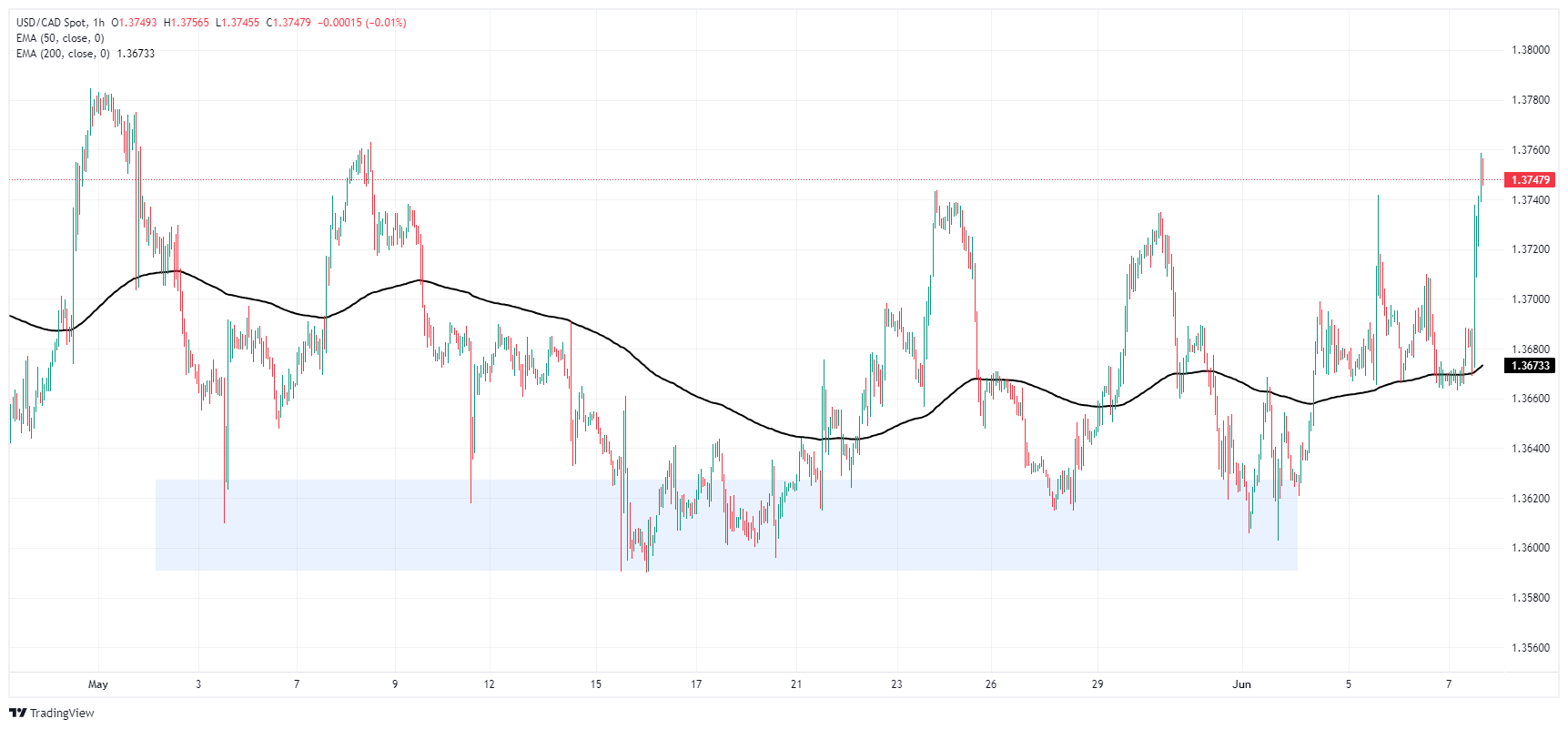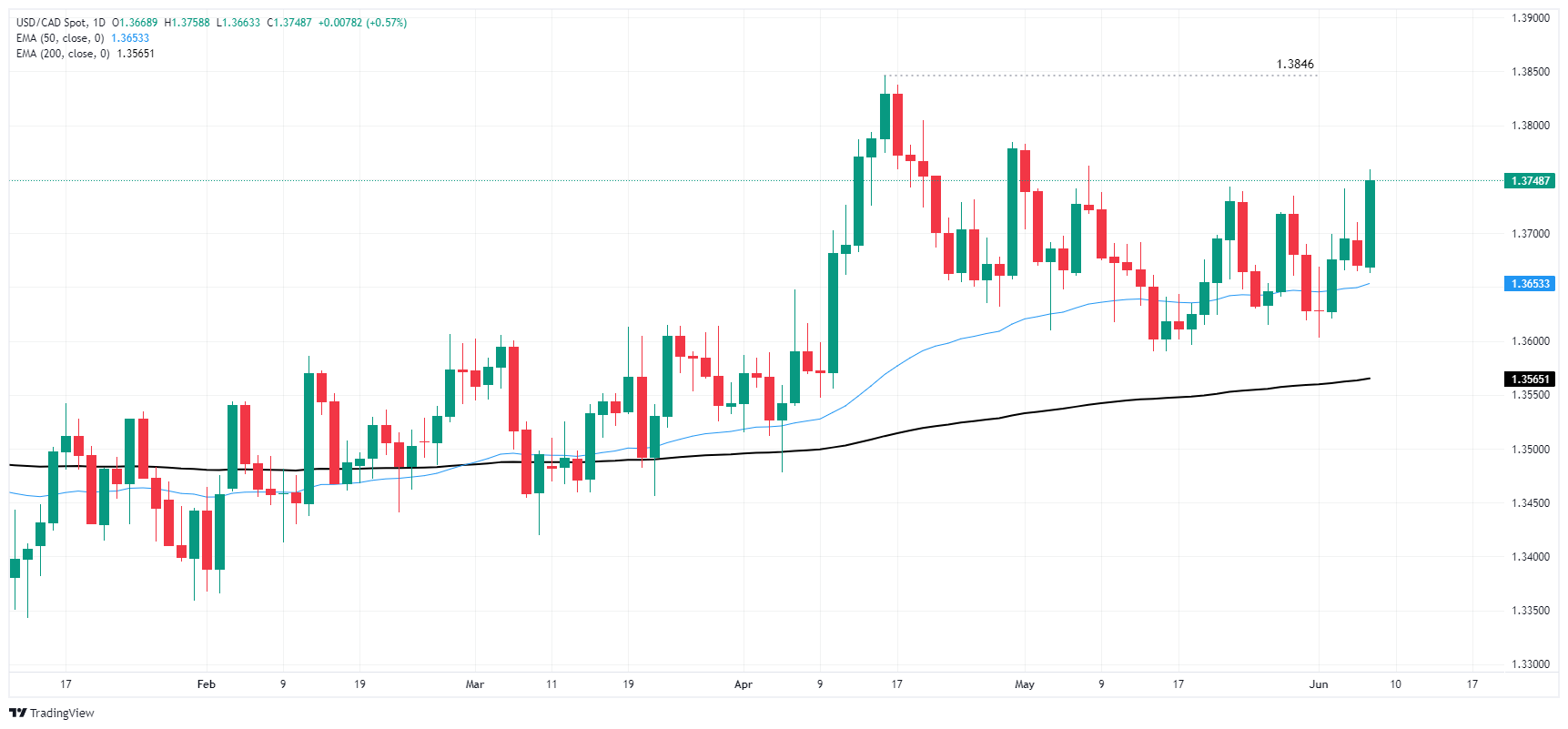- The Canadian Dollar falls 0.6% against the US Dollar on Friday.
- Canada added more jobs than expected, but it is dwarfed by the US NFP.
- Strong job additions and rising wages dampen rate cut hopes.
The Canadian Dollar (CAD) is performing mixed on Friday, rising against most of its major currency pairs but falling against the US Dollar (USD). The CAD lost six tenths of a percent against the Dollar after a strong US Non-Farm Payrolls (NFP) report boosted the USD broadly, as investor hopes for a September rate cut by the of the Federal Reserve (Fed) fade away.
Canada added more jobs than expected in May, but the figure was still well below previous figures, limiting the CAD’s bullish momentum. Hourly wages also gained ground in both Canada and the US, while the US unemployment rate rose, a note of caution on a Friday that otherwise beat market forecasts.
Daily moves and market drivers: New job additions reduce rate cut bets
- The US NFP added 272,000 net new jobs in May, beating the forecast of 185,000, although the previous month’s figure was revised down to 165,000 from 175,000.
- The US unemployment rate rose to 4.0% in May, a 28-month high.
- Average hourly earnings in the US rose 0.4% month-on-month in May, above the 0.3% forecast and doubling the previous 0.2%.
- Canada’s net change in employment rose to 26,700 in May, above the 22,500 forecast but still well below the previous month’s 90,400.
- According to the CME’s FedWatch tool, investors’ hopes for a September rate cut by the Fed were firmly hit by US data on Friday. Rate traders are pricing in just a 55% chance of at least a quarter-point cut from the Fed on September 8, down from more than 70% before the US NFP report.
Price of the Canadian Dollar Today
The table below shows the percentage change of the Canadian Dollar (CAD) against the major currencies listed today. The Canadian Dollar was the weakest against the US Dollar.
| USD | EUR | GBP | JPY | CAD | AUD | NZD | CHF | |
|---|---|---|---|---|---|---|---|---|
| USD | 0.76% | 0.50% | 0.66% | 0.59% | 1.18% | 1.39% | 0.79% | |
| EUR | -0.76% | -0.24% | -0.14% | -0.17% | 0.42% | 0.69% | 0.01% | |
| GBP | -0.50% | 0.24% | 0.12% | 0.07% | 0.67% | 0.93% | 0.25% | |
| JPY | -0.66% | 0.14% | -0.12% | -0.05% | 0.53% | 0.76% | 0.14% | |
| CAD | -0.59% | 0.17% | -0.07% | 0.05% | 0.59% | 0.87% | 0.18% | |
| AUD | -1.18% | -0.42% | -0.67% | -0.53% | -0.59% | 0.26% | -0.42% | |
| NZD | -1.39% | -0.69% | -0.93% | -0.76% | -0.87% | -0.26% | -0.66% | |
| CHF | -0.79% | -0.01% | -0.25% | -0.14% | -0.18% | 0.42% | 0.66% |
The heat map shows the percentage changes of the major currencies against each other. The base currency is chosen from the left column, while the quote currency is chosen from the top row. For example, if you choose the Canadian Dollar from the left column and move along the horizontal line to the US Dollar, the percentage change shown in the box will represent CAD (base)/USD (quote).
Technical Analysis: Canadian Dollar Makes Some Gains as US Dollar Soars
The Canadian Dollar (CAD) fell six-tenths of a percent against the Greenback on Friday, but remained firm. The CAD rose three-quarters of a percent against the New Zealand Dollar (NZD) and six-tenths of a percent against the Australian Dollar (AUD). The CAD is also up within a fifth of a percent against the Euro (EUR) and the Swiss Franc (CHF).
USD/CAD reached new short-term highs above 1.3750 on Friday, colliding with the ceiling of recent consolidation patterns. The pair is set to continue moving sideways in the medium term as the Dollar’s purchasing power evaporates at familiar technical highs.
Daily candlesticks show the pair is on track to see its strongest close in over a month, and clashing with its highest bids since early May. Consolidation remains the name of the game in the long term, although USD/CAD continues to make gains on the chart above the 200-day exponential moving average (EMA).
USD/CAD Hourly Chart
USD/CAD Daily Chart
The Canadian Dollar FAQs
The key factors that determine the price of the Canadian Dollar (CAD) are the level of interest rates set by the Bank of Canada (BoC), the price of oil, Canada’s main export product, the health of its economy, inflation and the trade balance, which is the difference between the value of Canadian exports and its imports. Other factors are market confidence, that is, whether investors bet on riskier assets (risk-on) or look for safe assets (risk-off), with the risk-on being positive for the CAD. As its largest trading partner, the health of the US economy is also a key factor influencing the Canadian dollar.
The Bank of Canada (BoC) exerts significant influence over the Canadian Dollar by setting the level of interest rates that banks can lend to each other. This influences the level of interest rates for everyone. The BoC’s main objective is to keep inflation between 1% and 3% by adjusting interest rates up or down. Relatively high interest rates are usually positive for the CAD. The Bank of Canada can also use quantitative easing and tightening to influence credit conditions, with the former being negative for the CAD and the latter being positive for the CAD.
The price of oil is a key factor influencing the value of the Canadian Dollar. Oil is Canada’s largest export, so the price of oil tends to have an immediate impact on the value of the CAD. Generally, if the price of oil rises, the CAD also rises, as aggregate demand for the currency increases. The opposite occurs if the price of oil falls. Higher oil prices also tend to lead to a higher probability of a positive trade balance, which also supports the CAD.
Although inflation has traditionally always been considered a negative factor for a currency, as it reduces the value of money, the opposite has actually happened in modern times, with the relaxation of cross-border capital controls. Higher inflation often leads central banks to raise interest rates, attracting more capital inflows from global investors looking for a lucrative place to store their money. This increases the demand for the local currency, which in the case of Canada is the Canadian Dollar.
The published macroeconomic data measures the health of the economy and may have an impact on the Canadian dollar. Indicators such as GDP, manufacturing and services PMIs, employment and consumer confidence surveys can influence the direction of the CAD. A strong economy is good for the Canadian dollar. Not only does it attract more foreign investment, but it may encourage the Bank of Canada to raise interest rates, resulting in a stronger currency. However, if economic data is weak, the CAD is likely to fall.
Source: Fx Street
I am Joshua Winder, a senior-level journalist and editor at World Stock Market. I specialize in covering news related to the stock market and economic trends. With more than 8 years of experience in this field, I have become an expert in financial reporting.







